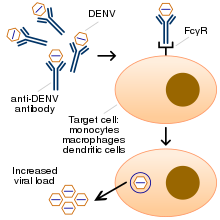Influenza A virus subtype H7N9
Influenza A virus subtype H7N9 (A/H7N9) is a bird flu strain of the species Influenza virus A (avian influenza virus or bird flu virus). Avian influenza A H7 viruses normally circulate amongst avian populations with some variants known to occasionally infect humans. An H7N9 virus was first reported to have infected humans in March 2013, in China.[2] Cases continued to be reported throughout April and then dropped to only a few cases during the summer months. At the closing of the year, 144 cases had been reported of which 46 had died.[3][4][5] It is known that influenza tends to strike during the winter months, and the second wave, which began in October, was fanned by a surge in poultry production timed for Chinese New Year feasts that began at the end of January. January 2014 brought a spike in reports of illness with 96 confirmed reports of disease and 19 deaths.[6][7] As of April 11, 2014, the outbreak's overall total was 419, including 7 in Hong Kong, and the unofficial number of deaths was 127.[8][9][10]
A 5th epidemic of the H7N9 virus began in October 2016 in China. The epidemic is the largest since the first epidemic in 2013 and accounts for about one-third of human cases ever reported.[11][12] The cumulative total of laboratory-confirmed cases since the first epidemic is 1,223. About 40 percent have died.[13] The CDC estimates that the H7N9 virus has the greatest potential compared with other influenza A viruses to cause a pandemic, although the risk is low because, like other type A viruses, it is not easily transmitted between people in its current form.[12]
The World Health Organization (WHO) has identified H7N9 as "...an unusually dangerous virus for humans."[14] Most of the cases resulted in severe respiratory illness, with a mortality rate of roughly 30 percent.[15][16] Researchers have commented on the unusual prevalence of older males among H7N9-infected patients.[17] While several environmental, behavioral, and biological explanations for this pattern have been proposed,[18] the reason remains unknown.[19]
It has been established that many of the human cases of H7N9 appear to have a link to live bird markets.[20] As of January 2014, there has been no evidence of sustained human-to-human transmission;[5] however, a study group headed by one of the world's leading experts on avian flu reported that several instances of human-to-human infection are suspected.[21] The H7N9 virus does not kill poultry, which makes surveillance much more difficult.[citation needed]
Chinese scientists announced the development of a vaccine on October 26, 2013, but said that H7N9 had not spread far enough to merit widespread vaccination.[22][23] Research regarding background and transmission is ongoing.[24]
Influenza A viruses are divided into subtypes based on two proteins on the surface of the virus: hemagglutinin (HA) and neuraminidase (NA). The avian influenza A(H7N9) virus designation of H7N9 identifies it as having HA of the H7 subtype and NA of the N9 subtype.[25]


